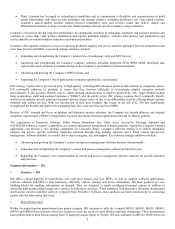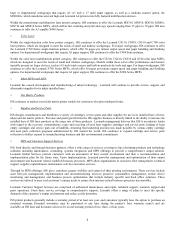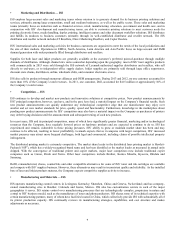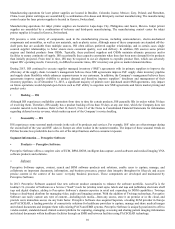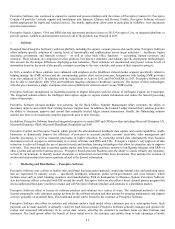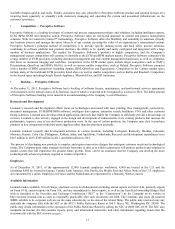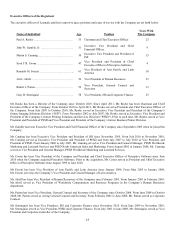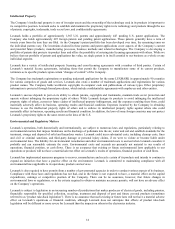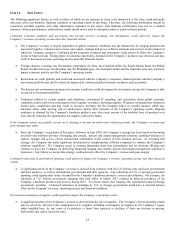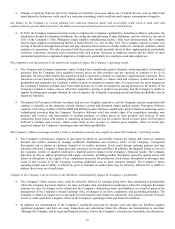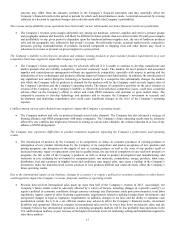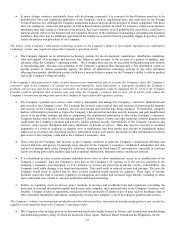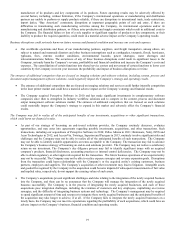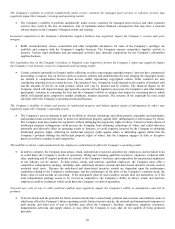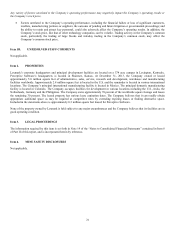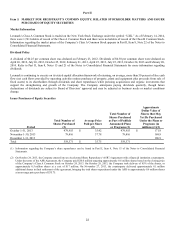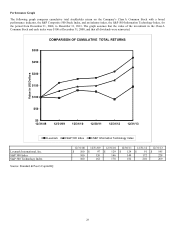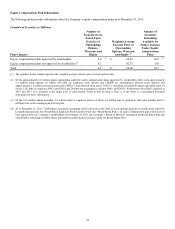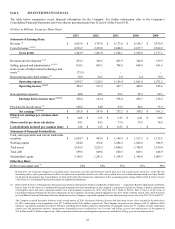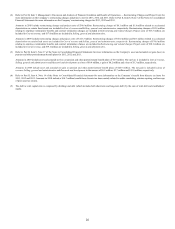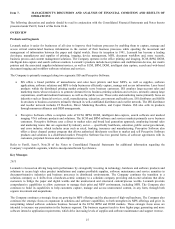Lexmark 2013 Annual Report Download - page 21
Download and view the complete annual report
Please find page 21 of the 2013 Lexmark annual report below. You can navigate through the pages in the report by either clicking on the pages listed below, or by using the keyword search tool below to find specific information within the annual report.
outcome may differ from the amounts recorded in the Company’s financial statements and may materially affect the
Company’s financial results in the period or periods for which such determination is made. A material assessment by a taxing
authority or a decision to repatriate foreign cash could adversely affect the Company’s profitability.
The revenue and profitability of our operations have historically varied, which makes our future financial results less predictable.
The Company’s revenue, gross margin and profit vary among our hardware, software, supplies and services, product groups
and geographic markets and therefore will likely be different in future periods than our current results. Overall gross margins
and profitability in any given period is dependent upon the hardware/software/supplies mix, the mix of hardware products
sold, and the geographic mix reflected in that period’s revenue. Overall market trends, seasonal market trends, competitive
pressures, pricing, commoditization of products, increased component or shipping costs and other factors may result in
reductions in revenue or pressure on gross margins in a given period.
The Company’s inability to develop new products and enhance existing products to meet customer product requirements on a cost
competitive basis may negatively impact the Company’s operating results.
The Company’s future operating results may be adversely affected if it is unable to continue to develop, manufacture and
market products that are reliable, competitive, and meet customers’ needs. The markets for laser products and associated
supplies and content/process management software are aggressively competitive, especially with respect to pricing and the
introduction of new technologies and products offering improved features and functionality. In addition, the introduction of
any significant new and/or disruptive technology or business model by a competitor that substantially changes the markets
into which the Company sells its products or demand for the products sold by the Company could severely impact sales of
the Company’s products and the Company’s operating results. The impact of competitive activities on the sales volumes or
revenue of the Company, or the Company’s inability to effectively deal with these competitive issues, could have a material
adverse effect on the Company’s ability to attract and retain OEM customers and maintain or grow market share. The
competitive pressure to develop technology and products and to increase the Company’s investment in research and
development and marketing expenditures also could cause significant changes in the level of the Company’s operating
expense.
Conflicts among various sales channels may negatively impact the Company’s operating results.
The Company markets and sells its products through several sales channels. The Company has also advanced a strategy of
forming alliances and OEM arrangements with many companies. The Company’s future operating results may be adversely
affected by any conflicts that might arise between or among its various sales channels, the volume reduction in or loss of any
alliance or OEM arrangement.
The Company may experience difficulties in product transitions negatively impacting the Company’s performance and operating
results.
The introduction of products by the Company or its competitors, or delays in customer purchases of existing products in
anticipation of new product introductions by the Company or its competitors and market acceptance of new products and
pricing programs, any disruption in the supply of new or existing products as well as the costs of any product recall or
increased warranty, repair or replacement costs due to quality issues, the reaction of competitors to any such new products or
programs, the life cycles of the Company’s products, as well as delays in product development and manufacturing, and
variations in cost, including but not limited to component parts, raw materials, commodities, energy, products, labor rates,
distributors, fuel and variations in supplier terms and conditions, may impact sales, may cause a buildup in the Company’s
inventories, make the transition from current products to new products difficult and could adversely affect the Company’s
future operating results.
Due to the international nature of our business, changes in a country’s or region’s political or economic conditions or other factors
could negatively impact the Company’s revenue, financial condition or operating results.
Revenue derived from international sales made up more than half of the Company’s revenue in 2013. Accordingly, the
Company’s future results could be adversely affected by a variety of factors, including changes in a specific country’s or
region’s political or economic conditions; foreign currency exchange rate fluctuations; trade protection measures; local labor
regulations; import, export or other licensing requirements; requirements related to making foreign direct investments; and
unexpected changes in legal or regulatory requirements. In addition, changes in tax laws and the ability to repatriate cash
accumulated outside the U.S. in a tax efficient manner may adversely affect the Company’s financial results, investment
flexibility and operations. Moreover, margins on international sales tend to be lower than those on domestic sales, and the
Company believes that international operations in emerging geographic markets will be less profitable than operations in the
U.S. and European markets, in part, because of the higher investment levels for marketing, selling and distribution required to
enter these markets.
17


